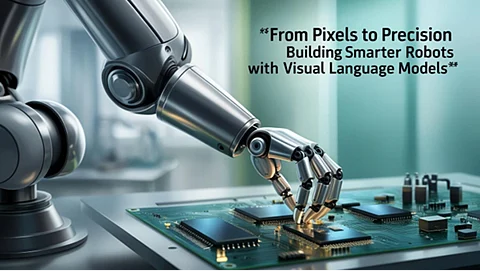From Pixels to Precision: Building Smarter Robots with Visual Language Models
Revolutionary strides in artificial intelligence are reshaping how machines perceive and interact with the world. At the heart of this transformation lies the emergence of Visual Language Models (VLMs), which blend visual perception with natural language understanding to create robots that can reason, respond, and adapt more intuitively than ever before. Prashant Anand Srivastava, a Senior Software Engineer, brings together technical depth and visionary thinking to explore how these systems are moving beyond the lab and into dynamic, real-world environments.
Beyond Vision: Architecting Human-Like Perception
Modern Visual Language Models represent a confluence of image recognition and linguistic reasoning. By fusing visual encoders with transformer-based text processors, these systems create a unified semantic space where robots can interpret scenes and respond to commands with human-like nuance. The implementation of models like vision transformers (ViTs) has revolutionized image analysis, enabling robots to comprehend complex spatial arrangements. Cross-modal attention further enhances their ability to resolve ambiguities and deliver accurate responses—even in environments rife with occlusion and clutter.
Data Quality and Learning Strategies: The Backbone of Robustness
The success of VLMs hinges not just on architecture but on the data and methodologies used for training. Recent breakthroughs in contrastive learning offer ways to drastically reduce computational loads while maintaining high representational fidelity. Region-based contrastive learning has significantly improved training efficiency, enabling researchers with limited resources to compete. However, the lack of high-quality, context-rich datasets still hampers deployment. Precision in training data, more than sheer volume, is proving crucial for developing systems that perform reliably in the nuanced and physically demanding environments of real-world robotics.
Failure Modes and Fragility: When Robots Meet the Real World
Despite impressive lab results, VLMs struggle under uncontrolled conditions. The models show a stark performance decline—accuracy dropping from 94.3% to 37.8%—when exposed to variable lighting, and demonstrate significant cultural bias, with object recognition accuracy plummeting by 48.4 percentage points between familiar and unfamiliar cultural items. These issues stem from environmental variability, dataset bias, and multimodal misalignment. Proposed mitigation strategies include domain randomization, culturally diverse training data, and embodied learning methods, all aimed at reducing hallucinations and improving contextual alignment.
Memory and Multimodal Grounding: Building Situational Awareness
Effective robotic behavior relies on more than isolated perception—it demands memory and the ability to interpret vague or spatially ambiguous instructions. By integrating temporal memory and multimodal reasoning, recent systems can maintain context across sequential interactions and resolve deictic expressions like “that one over there.” Models trained with temporal context have achieved near-doubling of performance in tasks requiring sequence memory, while multimodal grounding frameworks have shown up to 93% accuracy in interpreting spatial commands, significantly improving real-world task completion.
Designing for Ethics: Privacy, Safety, and Trust
Deploying robots with VLMs in sensitive environments poses a weighty concern. Privacy risks are massive, with studies going on to affirm the possibility of accidental exposure of 35% of sensitive data in captured images. Some other suggested mitigations to privacy risk include the application of privacy-preserving transformations within the model architecture itself. Safety is another concern, as language-directed robots may execute dangerously unintended instructions if instructions are misinterpreted. Since formal verification techniques that mathematically preclude unsafe outcomes have shown a 67% improvement in safety, in addition, transparency is also related to this matter. Explanation systems that describe the logic of decisions have proven to significantly increase user trust and coordination of operations.
Roadmap to Advancement: Three Pillars of Progress
Three primary pathways promise transformative advancements for VLM-powered robotics:
Human-in-the-Loop Systems: Considering that, from this point in time, are offering the highest levels of near-term feasibility, these systems combine active learning and uncertainty estimation with automation and human intervention, bringing flexibility and reliability to the forefront.
Continual Learning Frameworks: These allow VLMs to develop in an ever-changing landscape. Techniques such as rehearsal memory and regularization allow VLMs to maintain access to previous knowledge while learning new skills, which will be important for sustainability.
Embodied Intelligence: While the most technically difficult, this property allows robots to take physical action with their environment, grounding abstract language in sensory experience. This form of learning gives robots far fewer chances to make inferences and improve their manipulation strengths.
Visual Language Models are pushing robotic systems toward increased autonomy and reliability by addressing key challenges of perception, learning, and interaction. They have developed from a multidisciplinary effort toward a bridge between artificial and human intelligence.
In conclusion, the pathway to the deployment of VLM-powered robots in real-world scenarios is lined with both promise and complexity. Environmental adaptability, cultural inclusivity, and ethical safeguards must be systematically addressed. With advances in model architecture, learning methods, and ethical frameworks, robots can thus become friendly collaborators in everyday life. The work of Prashant Anand Srivastava illuminates the technical landscape around VLMs and maps the viewpoint of their deployment responsibly and effectively within diverse and dynamic environments.
.png)

